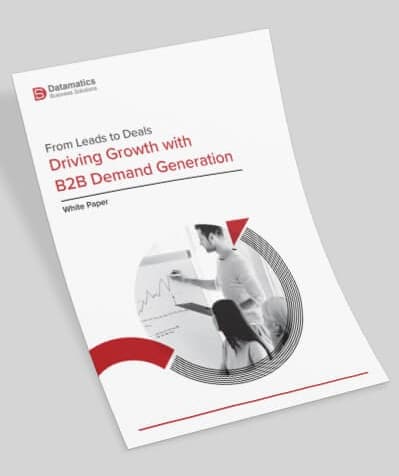Today, marketing is no longer only about promoting products. CMOs and marketing teams are expected to be more integral in the company’s current & future strategy especially when taken that message to market and helping grow the organization. There has been thus a tremendous shift in the way marketing teams and CMOs approach their work today with a major focus to seek new business growth avenues, quality demand generation and ultimately posing the question of marketing efficiency and marketing effectiveness.
Over the last decade, CMOs have focused and done very well on marketing efficiency metrics by leveraging MarTech or marketing automation. However, the challenge lies in creating effectiveness. The major question remains – Are the generated leads by Marketing qualified and recognized as valuable leads by the Sales team? The effectiveness challenge spurts out when the leads don’t translate into revenue.
To look at the efficiency vs effectiveness from a different lens and reduce the gap between the two, there is a need to redesign and realign the process. Having a progressive marketing scorecard can help this endeavor.
Table of Contents
Progressive Marketing Scorecard
Progressive Marketing Scorecard is a four-fold approach towards enhancing the marketing function and ensuring it contributes more to the success of the sales function and ultimately revenue growth.
MQL Volume
The number of Marketing Qualified Leads (MQLs) is a reflection of the success of marketing campaigns. It is necessary to generate leads that fit the pre-defined criteria of qualification and show promise of converting into clients. The volume of MQLs is basically the number of individuals or businesses that have met these criteria. A large MQL volume is more likely to translate into more conversions and subsequently, increased ROI.
MQL Velocity
MQL velocity refers to the rate at which MQLs are generated and move through the funnel. MQL Velocity is an important metric for businesses because it helps them understand the effectiveness of their marketing campaigns and how well they are able to convert leads into paying customers.
CMOs must not only focus on the rate at which the MQLs are entering the funnel but more on the rate at which these MQLs are converting into sales revenues. There should be a revenue number, timestamp and long-term value in the funnel and leads generated. This must bring co-ownership and collaboration of marketing and sales functions to build an ecosystem that is eventually about sales revenues.
Marketing Head Co-owning a Revenue Number
The primary purpose of every growth engine is to generate revenue and boost business growth. The best filter to gauge marketing effectiveness is to monitor the revenue number that the marketing function is bringing to the table. Further, CMOs should also keep a close eye on the percentage of that lead revenue that gets converted into sales revenues. This creates an ecosystem where only the leads with high propensity are generated, and nurtured, optimizing the time, efforts and cost of the marketing function.
LTV/CAC
Taking Marketing Effectiveness to the next level is not looking at short term but training marketing for the long-term view. Lifetime value (LTV) is a financial metric that represents the amount of revenue that a customer is expected to generate for a business over the course of their lifetime. Customer acquisition cost (CAC) is the amount of money that a business needs to spend in order to acquire a new customer. The ratio of LTV/CAC is used to measure the efficiency of the company’s customer acquisition strategy, The higher the ratio, the more profitable is the strategy and vice versa.
CMOs must own the operating model of their channels to optimize the LTV/CAC ratio. While they focus on increasing the revenue and monitor the business they bring in, they must also keep one eye on the cost required to acquire the customer (CAC). This is a mature way of driving effectiveness but this needs a much more strategic mindset across the senior management and board also.
Marketing & Sales Collaboration – The Pacing Element
Consider the analogy of a 4*100m relay race. The job of a runner is not done after handing over the baton to the next runner. The job of a runner is done when his team wins!
Drawing into the same analogy from a business point of view, the job of a marketer is not done after generating leads. The job of a marketer is done when the lead is qualified and converts into business revenue. The revenue growth is impact by how well the two functions collaborate. There is a need to build a mechanism where sales and marketing can work cohesively and have complete clarity and understanding of how each function is contributing. This is the Pacing Element that organizations need to optimize their sales funnel and increase revenues. Without this pacing element, organizations run the risk of creating an ecosystem that leads to a lot of chaos in the system.
Since the CMOs co-own the funnel, they must not rest after handing over the baton (MQL) to the sales team. They must circle back and monitor the progress and take necessary measures to convert the lead.
Contribution of Marketing Function to the Sales Function
The marketing function plays a critical role in driving sales growth. Marketers must understand the end-end-to-end buying cycle and not limit themselves to lead generation. This will help them understand all the elements better to do justice to the communications and outgoing messages. Marketing can contribute more to sales by doing these three things right –
Strengthening the Top of the Funnel Foundation & Quality of Leads
Marketers must focus on improving the quality of leads generated, the Ideal Customer Profile (ICP) they are trying to create along with the value proposition. They must establish specific criteria for what constitutes an MQL, streamline the outreach strategies and understand the customer and market demands for effective communication.
Nurturing Leads through Drip Campaigns
Sometimes it happens that a marketing qualified lead might not move ahead in the sales funnel. In such a scenario, sales team can come back to marketing and inform them about the status. Further, marketing team can roll such leads back into a drip campaign to understand the needs and challenges of the prospect and re-engage in a better way. They can ensure there is an uplift in the interest and then pass it back to the sales team.
Branding
If the marketing function is trying to create a long-term value, there is great impetus on the branding aspect. Strong brand recognition translates into increased trust in your products and services. People are already aware of your offerings and have a brief understanding of your brand. If a sales leader walks into a conference or an event and there is instant brand recognition, the job becomes easier.
Conclusion
In summary, CMOs have always faced the challenge of balancing marketing efficiency and marketing effectiveness. While technology has enabled teams to automate and streamline operations, the true measure of success lies in generating leads that convert into revenue. By focusing on the above key ideas and strategies, CMOs can ensure that their marketing efforts are driving real business growth. And at the end, organizations need to foster collaboration and co-ownership between marketing and sales teams that ensures alignment of business efforts and the creation of a more effective ecosystem for generating revenue.

